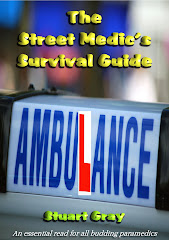Seven calls – one hoax , one no-trace, one taken by police to hospital and four by ambulance.
A reasonably calm start for my first day back I think, although I was quickly reminded of frontline reality when the first call, for a 16 year-old female who was being assaulted by a collapsed male in the street turned out to be a hoax, resulting in me, an ambulance and a police car scooting around the King’s Cross area vainly looking for a job to do. A motorcycle paramedic had been dispatched too, for good measure, but his time was being wasted too and he didn’t stay on scene long.
Later on, a 26 year-old patient with a heart condition (which is rarely specified and so could be anything from an infection to a dodgy valve) required an ambulance because he was experiencing pains up and down his back. This, incidentally, was accompanied by DIB but I rather doubted the connection, although I wouldn’t stake my career on it – these things are always worth checking out. Unfortunately, a crew arrived directly behind me as I got out of the car and I became excess to requirements.
I was whiling away the time on stand-by when a call came in for a 35 year-old man who was ‘standing in the middle of the road, covered in blood’. Now, this will usually get someone’s attention. Not only that but he chose to carry out his stunt in front of a hospital. I think I’ve explained before that an ambulance will usually be called for you, even if you have collapsed on the doorstep of the hospital because the staff are not insured to treat you in the street. So, you can forget most of what you see on Casualty. They won’t be running out to get you. They will probably watch you from the windows until an ambulance arrives and takes you the couple of metres inside the hospital premises.
When I got on scene, the patient was nowhere to be found. I called it in as a possible hoax but a concerned looking man approached me.
‘Are you looking for the bloke who was in the middle of the road?’ he asked.
‘Yes.’ I replied.
‘He was there but he’s gone now. He was covered in blood and he just stood in the road chucking things at the passing cars.’
The hospital ambulance bays were full, so I figured a crew might have seen him and taken him inside. Either that or he had wandered off to an even busier road. I decided to check with the hospital staff first.
Sure enough, as I went into the Majors department, security men were standing over a blood-spattered man with wild, ‘mental-health-issues’ eyes. I confiasked one of my colleagues if this was the object-throwing maniac from earlier and he confirmed that it was. The police had found him and brought him here. I watched as a cleaner mopped up the drops of blood he had brought in with him.
So far I hadn’t actually made any clinical contact with a patient and the day was ebbing away. I’m not complaining but I get bored if I’m not doing something useful. Luckily, my next patient broke the pattern. She was a 26 year-old Polish woman who, according to witnesses, had been hit by a speeding cyclist who was travelling along the wrong side of the road. He collided with her as she tried to cross over. She went flying and sustained a lower back injury. A private ambulance crew had stopped to render aid, so I got a bit of a handover from them.
A taxi driver witnessed the incident and was happy to give his name and address (I don’t think he liked the cyclist) so I went to talk to the alleged assailant. He was a tall, gangly man and he lied I think. Not only hadid he tell me he was going at a snail’s pace when he hit the woman but he became indignant and pedalled off when I suggested he wait for the police to get the story sorted out.
The crew took her to hospital and the police were asked to meet her there. The cyclist will probably never be caught.
An Motorcycle paramedic was already on scene and dealing with my next patient, a 40 year-old man who had fitted outside a shop. I helped out but, again, didn’t have much to do with the patient.
Rail staff called us for a male who was fitting at a train station in south London but when I arrived, on the tail of an ambulance, the motorcycle responder told us that the patient had left the scene of his own accord. I know the area quite well and there is an alcoholic man who regularly calls (or has others call) ambulances for his alleged ‘fitting’ episodes. Sometimes he waits to be seen and sometimes he doesn’t. I suspect today, he didn’t.
Finally, just as I was trying to get back to book off, I got a late job. A 35 year-old male had been knocked off his cycle by a car. The car had hit him at speed as he attempted to turn right at a junction. The cyclist had allegedly cut across his path and been struck for his troubles. Again, strangely, a private ambulance crew (from the same company) had stopped and were helping him. The patient had neck, rib and hip injuries and was in a good deal of pain, although I doubted his life was at risk.
An LAS crew arrived and we got him collared and boarded and in the back of the vehicle while he sucked on an entonox mouthpiece to relieve his pain, most of which was coming from his hip joint. Other than that, he seemed perfectly stable.
I gave him morphine and he settled down in the ambulance. Then we set off for hospital, got him inside and I went back to my station, glad to be getting home, albeit over an hour later than I should have. Ambulance crews cop worse than me though, some of them will work a couple of hours overtime on late jobs and will still be expected to get in on time the next day for another twelve hour shift. Eventually, it wears you down, especially if one shift after the other has been like that.
Well, at least the first part of my day allowed me to mesh back into my role. I also got my new boots, so I can ditch the ones I have because they are worn through and I have been getting wet feet when it rains.
Be safe.
Subscribe to:
Post Comments (Atom)















8 comments:
Sounds like a frustrating day!
You miss working in an Ambulance? Or with a crew mate?
Hi
Nice to have you back, Hope you had a nice holiday and well earned rest.
Take care
Hi, I'm new here and stumbled across your blog while surfing the web, all I can say already is that
I love it and you have an incrediable talent and are able to "transform" the reader directly to the scene and we are able to get a first hand experience. Keep it up.
I noticed in your Bio (and in older posts, which I have been reading to get a background) section that you said you were a paramedic in the army, I just wanted to know if it is possible to train as a Paramedic (ie not an EMT) through the amry ? Thanks :)
Welcome back! You've gained a new reader. I've been catching up on your 2007 work, and have to force myself to stop for sleep, work etc. You do an admirable job, and it is a pleasure to read about it.
Glad you're back, I've missed reading your posts!
"I think I’ve explained before that an ambulance will usually be called for you, even if you have collapsed on the doorstep of the hospital because the staff are not insured to treat you in the street. So, you can forget most of what you see on Casualty. They won’t be running out to get you. They will probably watch you from the windows until an ambulance arrives and takes you the couple of metres inside the hospital premises." That's ridiculous! (Not what you said, but the fact!) Surely the patient could walk into A&E, and if he couldn', he would probably be seriously injured so wouldn't the nurses come out to meet him? What a nutty NHS we have!(not the 'frontliners' the management!)
Glad to see you back and I hope you enjoyed your break!
It's not that they're not insured, there are lots of other reasons...
If you see patients outside, who are technically the ambulance service's responsibility, you're not seeing the patients inside (who are your responsibility), who may then suffer as a result.
How far do you take it? An RTA outside the door? A collapse down the street? Someone who fell down the stairs in the flats 5 minutes walk away....?
Hospital based staff aren't typically trained or equipped for pre-hospital care. This might not matter in the case of someone who just needs walking inside, but consider a patient in an entrapment situation who needs extrication... A&E nurses have probably never done it, and they almost certainly don't have the equipment. Hence an ambulance is required...
“… an ambulance will usually be called for you, even if you have collapsed on the doorstep of the hospital because the staff are not insured to treat you in the street.”
How long has this been going on? It must have been in recent times because I remember in the early nineties seeing a doctor who had gone right out of the grounds of his hospital with a wheelchair to where a policeman was standing over a collapsed jogger. This showed it could not have applied then (thankfully).
Despite the reasons stated here already, I still find this still disturbing and disheartening to know that this might be happening. It explains that really awful story in the newspapers recently about hospital staff refusing to help a man who was ill in his car just a few metres or so away from the hospital entrance. They were expecting his helper to call an ambulance. I thought this story was just a one-off and that was why it made the papers.
There goes my long-time hope that if I needed hospital treatment urgently, I could at least make it to the hospital grounds and avoid (purposely) ever being taken by ambulance. I sincerely hope if that happens I will be in a position to be “walked in” at least before collapsing.
Post a Comment